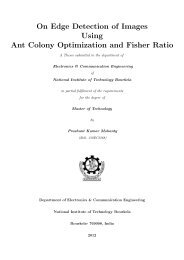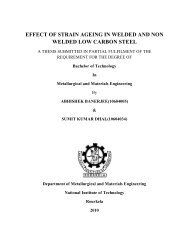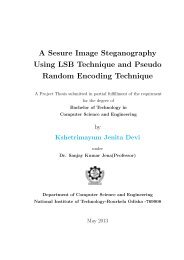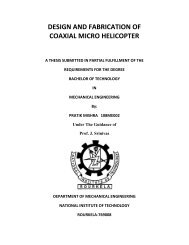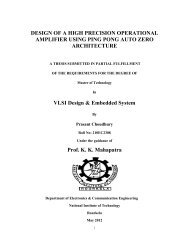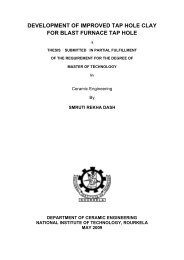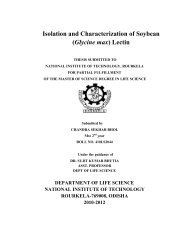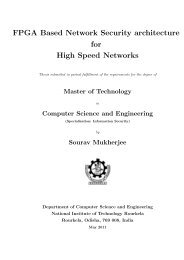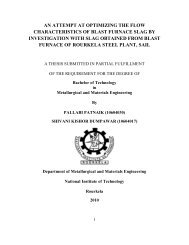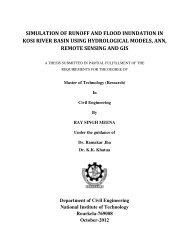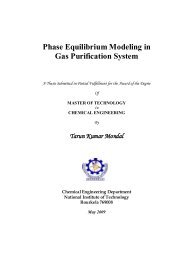analysis of transient heat conduction in different geometries - ethesis ...
analysis of transient heat conduction in different geometries - ethesis ...
analysis of transient heat conduction in different geometries - ethesis ...
You also want an ePaper? Increase the reach of your titles
YUMPU automatically turns print PDFs into web optimized ePapers that Google loves.
though the atmosphere has already become warm, the air <strong>in</strong>side the build<strong>in</strong>gs will rema<strong>in</strong><br />
comfortably cool for several hours. The reason for this phenomenon is the existence <strong>of</strong> a time lag<br />
before temperature equilibrium between the <strong>in</strong>side <strong>of</strong> the build<strong>in</strong>g and the outdoor temperature.<br />
Another typical example is the periodic <strong>heat</strong> flow through the walls <strong>of</strong> eng<strong>in</strong>es where<br />
temperature <strong>in</strong>creases only dur<strong>in</strong>g a portion <strong>of</strong> their cycle <strong>of</strong> operation. When the eng<strong>in</strong>e warms<br />
up and operates <strong>in</strong> the steady state, the temperature at any po<strong>in</strong>t <strong>in</strong> the wall undergoes cycle<br />
variation with time. While the eng<strong>in</strong>e is warm<strong>in</strong>g up, a <strong>transient</strong> <strong>heat</strong>-flow phenomenon is<br />
considered on the cyclic variations.<br />
1.4.3 One Dimensional unsteady <strong>analysis</strong><br />
In case <strong>of</strong> unsteady <strong>analysis</strong> the temperature field depends upon time. Depend<strong>in</strong>g on conditions<br />
the <strong>analysis</strong> can be one-dimensional, two dimensional or three dimensional. One dimensional<br />
unsteady <strong>heat</strong> transfer is found at a solid fuel rocket nozzles, <strong>in</strong> reentry <strong>heat</strong> shields, <strong>in</strong> reactor<br />
components, and <strong>in</strong> combustion devices. The consideration may relate to temperature limitation<br />
<strong>of</strong> materials, to <strong>heat</strong> transfer characteristics, or to the thermal stress<strong>in</strong>g <strong>of</strong> materials, which may<br />
accompany chang<strong>in</strong>g temperature distributions.<br />
1.5 DESCRIPTION OF ANALYTICAL METHOD AND NUMERICAL METHOD<br />
In general, we employ either an analytical method or numerical method to solve steady or<br />
<strong>transient</strong> <strong>conduction</strong> equation valid for various dimensions (1D/2D). Numerical technique<br />
generally used is f<strong>in</strong>ite difference, f<strong>in</strong>ite element, relaxation method etc. The most <strong>of</strong> the<br />
practical two dimensional <strong>heat</strong> problems <strong>in</strong>volv<strong>in</strong>g irregular <strong>geometries</strong> is solved by numerical<br />
techniques. The ma<strong>in</strong> advantage <strong>of</strong> numerical methods is it can be applied to any twodimensional<br />
shape irrespective <strong>of</strong> its complexity or boundary condition. The numerical <strong>analysis</strong>,<br />
due to widespread use <strong>of</strong> digital computers these days, is the primary method <strong>of</strong> solv<strong>in</strong>g complex<br />
<strong>heat</strong> transfer problems.<br />
The <strong>heat</strong> <strong>conduction</strong> problems depend<strong>in</strong>g upon the various parameters can be obta<strong>in</strong>ed through<br />
analytical solution. An analytical method uses Laplace equation for solv<strong>in</strong>g the <strong>heat</strong> <strong>conduction</strong><br />
problems. Heat balance <strong>in</strong>tegral method, hermite-type approximation method, polynomial<br />
approximation method, wiener–Hopf Technique are few examples <strong>of</strong> analytical method.<br />
5





